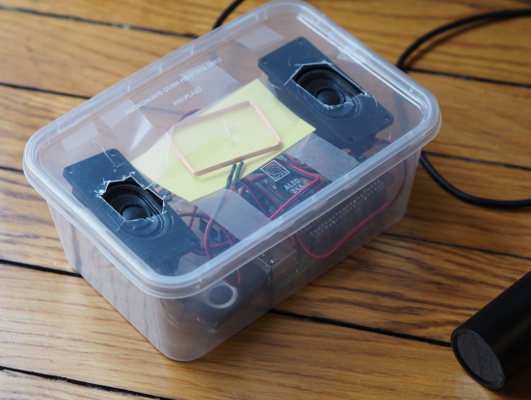Genesis
The seed of the idea was a project made by someone who inserted RFID tags in CD plastic cases in order to help an elderly member of his family. I couldn't remember the reference any more but, at the time, I found the idea fantastic.
The idea here is towards a young member of the family but general logic is the same: It has to be very easy to use.
Similar projects
Similar projects which can be found on the Internet, though. For example,
- Jukebox4kids The thread is in German but with videos of two different versions based on Arduino and Raspberry Pi. Cf Github RaspberryPi.Musicbox and Photo album as well.
⮕ These 2 jukeboxes are beautiful but I was aiming at something easier to use (10 months +) and simpler/cheaper to build!
⮕ A bit expensive, limited in number of "tokens", ...
⮕ Limited in number of songs
Design choices
Frequency
There are 2 main frequencies in the world of (short range) RFID : 125kHz and 13.56Mhz, the latter being used for NFC and smartcards as well. These days, availability and price of cards/tokens/readers doesn't seem to be an issue for either type.
I ended-up going to the 125kHz route a little bit by chance:
- Readers are very cheap and I had one collecting dust on my desk.
- The range is slightly shorter than with higher frequencies which could be beneficial to avoid interferences between the cards.
- Lower frequency might be less of a health hazard for a young child.
On the other hand, library books here and mobile phones are using the 13.56Mhz frequency. I might miss some opportunities of evolution. Who knows?
Arduino or Raspberry Pi?
After considering using an Arduino and a MP3 module, it turned out that there would be far more possibilities of evolution with a Raspberry Pi.
The main issue with Raspberry Pi/Linux is that both the card and filesystem are at risk if there are to many write IOs or the power is cut abruptly. These were mitigated using a Read-Only setup.
In term of price, a Raspberry Pi is slightly more expensive but (at the time of conception) I found some Raspberry Pi 3 for $25 delivered (from China (but UK made?)). Boot time (specially when using Python 3) is several time faster than with a Raspberry Pi B+ or zero even if these should be performing well enough.
Technical practicalities
SD Card & USB Flash
Although it is perfectly possible to store both the system and the data (music) on the same SD Card, the re-imaging of the system is a bit more complicated in this case. For the time being, I decided to keep them separate and store all the music aside on a USB Flash drive.
Boot time
A number of recipes exist to boot the system faster. It's particularly long on a old Raspberry but on a Raspberry 3, this doesn't seem to be too much of an issue (just a few seconds). So in the end, I didn't investigate much.
Read-Only
As mention earlier, the weak point on the Raspberry Pi platform is certainly the storage, specially with SD Card: They either wear quickly or end-up with a corrupted filesystem if the power is cut violently. This is a downside compare to a solution based on a Arduino for example.
In our case, it is essential to protect the card against this kind of bad treatment as one can't guarantee anything in the end of a child!
Two techniques seem to co-exist: The first one consist in using an overlay and any change will be written in RAM and lost during reboot. It as its advantages but wasn't that practical in the long run.
The second one, created, improved and popularised par K3A, Charles Hallard and Adafruit, ... has the big advantage of providing a way to switch RO to RW (and back) live, making updates very easy.
Storage of media
To keep things simple and to allow the use of the jukebox for multi-part music albums & stories, media are stored using the following structure:
1 card = 1 id = 1 album = 1 folder = 1 info file + 1 or more media files
The name of the album doesn't matter (usually something Composer-Title). A scan is ran at the start-up and the association id <-> path kept in memory.
In theory, it should be possible to read the content of a folder sorted by name, at random, etc... but so far this hasn't been implemented.
Type of cards & IDs
The info file in each folder can contain grouping tags (genre, ...) and a system of generic/group cards can be implemented (for example: "Dancing music at random" or "Lullabies" or "Bed time stories", ... This hasn't been fully implemented yet.
On the printing side of label, 2 types of cards (music / sounds) and several icons have been designed. There is currently no link with the tags cited above. More on these later.
Version 0 - Prototype
The first version created was to validated the concept. In order to keep things "easy", I decided to buy a ready made speaker solution (Adafruit I2S 3W Stereo Speaker Bonnet). The price of the bonnet + speakers + shipping (from a local reseller) ended-up in the same order of the Raspberry Pi 3 itself but it was supposed to be easier.
It turned out that VLC + Pulse Audio + "cheap" I2S is barely compatible and even after the tweaks, each song had variable level (from medium to loud) and was starting with a big plop. Usually after 2-3 songs, the whole system would crash and in need of a complete restart.
The jukebox was unstable and the packaging was ugly...

... but it was a great prototype and it was a instant hit with my little one!